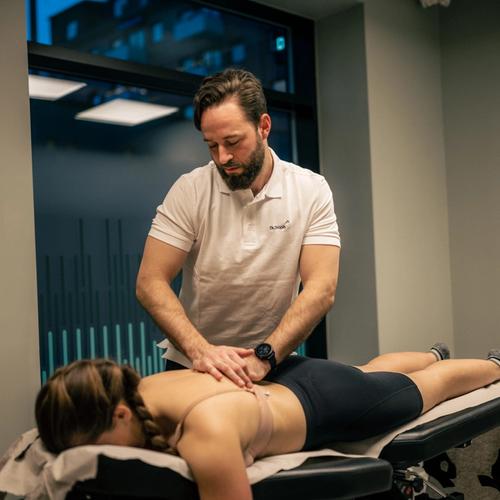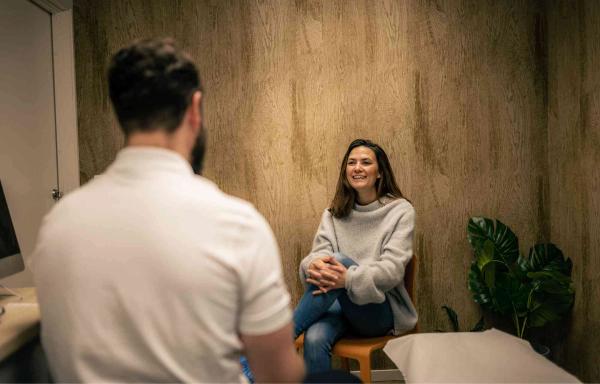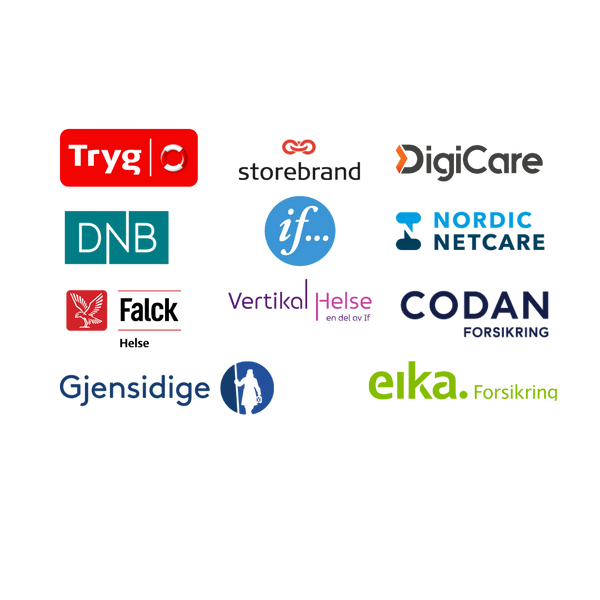Low back pain
Low back pain, also known as lumbago or lumbar pain, is a common condition that affects the lower portion of the spine. This can result in discomfort, limited mobility, and pain during activities such as bending, lifting, walking, or sitting. Lower back pain can have various causes, making it important to have the issue examined by professionals.
At Dr. Dropin, we have skilled practitioners who can assess your back issues and help you receive the appropriate treatment.
See availability
What are you looking for?
Symptoms of low back pain
Individuals suffering from lower back pain may experience a wide range of symptoms, including:
- Sharp or aching pain in the lower back.
- Pain that may radiate into the buttocks or down the legs, referred to as sciatica when it affects the sciatic nerve.
- Stiffness and limited mobility in the back.
- Pain that may worsen with activity or prolonged sitting.
Please note that these symptoms can have various causes, and it is important to seek professional help for an accurate diagnosis if you suspect this condition.
See availability
Treatment and prognosis
Treatment of lower back pain often involves different approaches to achieve specific treatment goals. Physiotherapists and chiropractors can play a vital role in helping patients manage these issues. Here are some common treatment measures:
- Pain relief: Through manual techniques such as joint adjustments, massage, and trigger point therapy, lower back pain can be reduced.
- Improved mobility: Through joint adjustments, soft tissue treatments, and specific stretching exercises, we can enhance the mobility and flexibility of the back.
- Strength training: Gradually introducing strength exercises for the back muscles can improve muscle strength and support the back's function.
- Functional rehabilitation: The goal is to assist patients in gradually returning to daily activities, work, and exercise, with an emphasis on restoring optimal back function.
It's important to understand that the treatment for lower back pain should be tailored to individual needs and may vary from person to person. A thorough evaluation and close collaboration with an experienced physiotherapist or chiropractor are essential for developing an effective treatment plan that suits each individual.
See availabilityWhen should you book an appointment?
If you recognize the symptoms above and are experiencing any of the following issues, we recommend seeking professional guidance:
- Pain or reduced mobility that has persisted for more than a week without improvement.
- Severe symptoms that you need assistance in reducing quickly.
- Symptoms that cause you concern or that you believe may be due to more serious conditions.
Remember that early assistance from a therapist can reduce the duration of your issues and contribute to achieving the best possible outcome. You should never worry that your problems are "too small" - we take all types of issues seriously.
See availability
Find clinic and therapist

Find therapist
Find a therapist that suits you and your needs by filtering on one or more criteria.

Telephone
Authorized healthcare personnel assist you over the phone. We answer the phone within 60 seconds. Free of charge.
Use your health insurance
We cooperate with all the major insurance companies, so that you can use your health insurance with us if you have low back pain or other problems.
Read more about how to use your health insurance here
What can you do by yourself?
While treatment for lower back pain typically involves professional guidance and therapy, there are several measures you can take on your own to alleviate symptoms and improve your lower back's condition:
Follow recommended exercises: If your therapist has provided you with home exercises, it's crucial to perform them regularly.
Stay active: Gentle activities like walking, preferably in uneven terrain, can expedite recovery and reduce pain.
Pain relief: Occasionally, pain can be reduced by using an ice pack, heating pad (or a warm shower), or performing gentle movements.
Medications: Use over-the-counter pain relievers as directed by a doctor.
Ergonomics: Adapt your workspace to find a work position that minimizes discomfort. Try adjusting your desk to lower or raise it. It's also wise to alternate between sitting and standing during work.
Adjust your activities: Avoid activities that lead to prolonged exacerbation of back pain (more than 12 hours).
Communicate with your therapist: Maintain an open dialogue with your therapist so that the treatment plan can be adjusted to any changes you experience.
If you haven't had your back pain examined or have strayed from the treatment plan, it's recommended to seek further guidance from healthcare professionals.
See availabilityFrequently asked questions about low back pain
What causes lower back pain?
Lower back pain can result from various factors, including muscle strains, disc herniation, overuse, or poor working posture.
What causes lower back pain?
Lower back pain can result from various factors, including muscle strains, disc herniation, overuse, or poor working posture.
How can I relieve lower back pain at home?
Try to stay active by going for frequent walks, perform recommended exercises, use an ice pack or heat therapy, and adjust your workstation for better ergonomics.
How can I relieve lower back pain at home?
Try to stay active by going for frequent walks, perform recommended exercises, use an ice pack or heat therapy, and adjust your workstation for better ergonomics.
When should I seek professional help for my lower back pain?
You should contact a healthcare professional if your pain persists for more than a week without improvement, is intense and requires rapid relief, or if you're concerned about more serious underlying causes. It is important to seek aid if you have muscle weakness, problems with bladder function or lack of sensation in the groin or both legs.
When should I seek professional help for my lower back pain?
You should contact a healthcare professional if your pain persists for more than a week without improvement, is intense and requires rapid relief, or if you're concerned about more serious underlying causes. It is important to seek aid if you have muscle weakness, problems with bladder function or lack of sensation in the groin or both legs.
What can a physiotherapist or chiropractor do for my lower back pain?
These professionals can assist with pain relief, improve back mobility, provide strength training, and offer functional rehabilitation.
What can a physiotherapist or chiropractor do for my lower back pain?
These professionals can assist with pain relief, improve back mobility, provide strength training, and offer functional rehabilitation.
Are there specific exercises that help with lower back pain?
Yes, specific stretching and strength exercises recommended by a therapist can help improve your lower back.
Are there specific exercises that help with lower back pain?
Yes, specific stretching and strength exercises recommended by a therapist can help improve your lower back.
Why is lower back pain so common?
This is a question without a simple answer. But its possible that low back pain is prevalent because the lower back is a complex area exposed to various stresses and injuries in our daily lives.
Why is lower back pain so common?
This is a question without a simple answer. But its possible that low back pain is prevalent because the lower back is a complex area exposed to various stresses and injuries in our daily lives.
How can I prevent lower back pain?
Prevention may include regular exercise, maintaining good posture, using proper lifting techniques, and making ergonomic adjustments in your workspace.
How can I prevent lower back pain?
Prevention may include regular exercise, maintaining good posture, using proper lifting techniques, and making ergonomic adjustments in your workspace.
What is the best sitting and sleeping position for lower back pain?
The best advice you can get is to choose positions that feel comfortable and relaxing, rather than positions that are perceived as uncomfortable or demanding. Additionally, it's important to incorporate a lot of variation, as it's common for a good position to become uncomfortable after a short while.
What is the best sitting and sleeping position for lower back pain?
The best advice you can get is to choose positions that feel comfortable and relaxing, rather than positions that are perceived as uncomfortable or demanding. Additionally, it's important to incorporate a lot of variation, as it's common for a good position to become uncomfortable after a short while.